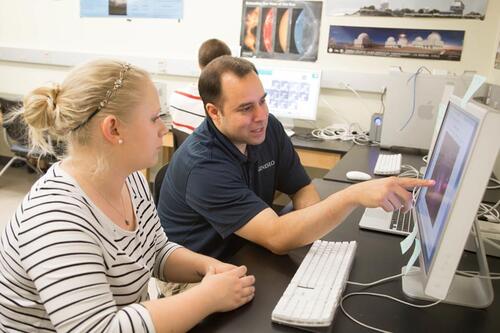
Professor of physics Aaron Steinhauer in the astronomy lab (SUNY Geneseo photo/Keith Walters '11)
The National Science Foundation’s Division of Astronomical Sciences has awarded a $166,212 grant to SUNY Geneseo to support a collaborative undergraduate research project on understanding stellar structure.
The three-year grant, led by professor of physics Aaron Steinhauer, will fund two undergraduate researchers per year to travel to Kitt Peak National Observatory in Arizona to collect and analyze data, attend an annual professional conference, and collaborate with research project colleagues from Indiana University Bloomington (the project’s lead institution) and the University of Kansas. The grant will also support Steinhauer’s summer research effort and travel to conferences, collaboration meetings, and observing runs in Indiana, Kitt Peak, and the Anglo Australian Telescope in Sydney, Australia.
“We are trying to understand better how stars are structured and evolve,” said Steinhauer. “We’ll be taking telescope observations of lots of stars in clusters to measure the amount of lithium there is at the surface. This abundance can reveal the effects of processes that occur below the visible surface of the stars.”
Lithium is one of only a few elements created in measurable quantities at the beginning of the universe, Steinhauer explained. By observing stars in ancient clusters, the team hopes to pin down the exact amount of lithium created then, which would help inform models of the Big Bang.
“This project will deepen our understanding of the universe and our place in it while promoting the training and engagement of young scientists,” said Steinhauer. “Geneseo has a strong tradition of genuine engagement of numerous students in research—many of them women—and of sustained mentorship of students. Students at the collaborating institutions will learn from each other and will be encouraged to help plan observing runs, go to telescopes to gather, process, and analyze data, present results at meetings, and help write up journal papers.”
The three-year project period for the grant is September 1, 2019, to August 31, 2022.